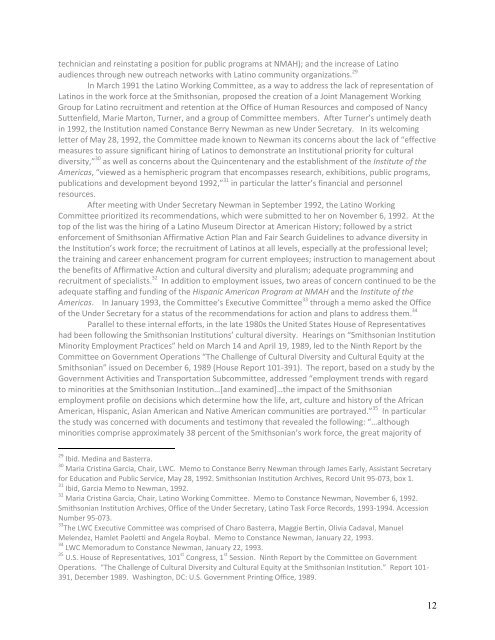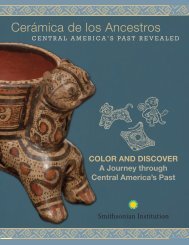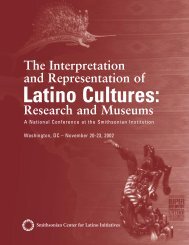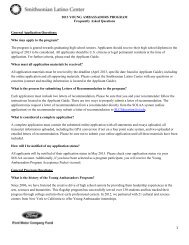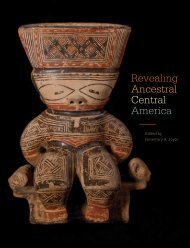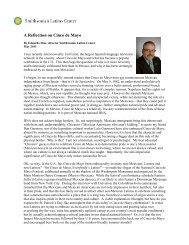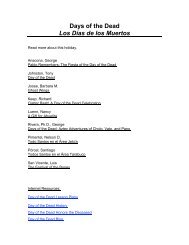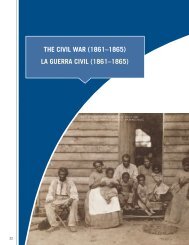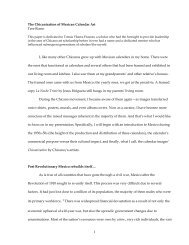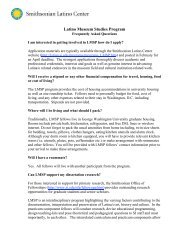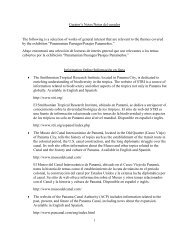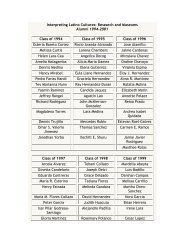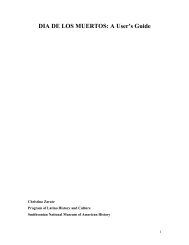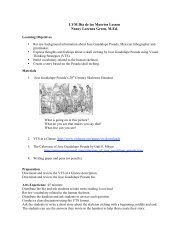smithsonian latino art collections - Smithsonian Latino Center
smithsonian latino art collections - Smithsonian Latino Center
smithsonian latino art collections - Smithsonian Latino Center
You also want an ePaper? Increase the reach of your titles
YUMPU automatically turns print PDFs into web optimized ePapers that Google loves.
technician and reinstating a position for public programs at NMAH); and the increase of <strong>Latino</strong><br />
audiences through new outreach networks with <strong>Latino</strong> community organizations. 29<br />
In March 1991 the <strong>Latino</strong> Working Committee, as a way to address the lack of representation of<br />
<strong>Latino</strong>s in the work force at the <strong>Smithsonian</strong>, proposed the creation of a Joint Management Working<br />
Group for <strong>Latino</strong> recruitment and retention at the Office of Human Resources and composed of Nancy<br />
Suttenfield, Marie M<strong>art</strong>on, Turner, and a group of Committee members. After Turner’s untimely death<br />
in 1992, the Institution named Constance Berry Newman as new Under Secretary. In its welcoming<br />
letter of May 28, 1992, the Committee made known to Newman its concerns about the lack of “effective<br />
measures to assure significant hiring of <strong>Latino</strong>s to demonstrate an Institutional priority for cultural<br />
diversity,” 30 as well as concerns about the Quincentenary and the establishment of the Institute of the<br />
Americas, “viewed as a hemispheric program that encompasses research, exhibitions, public programs,<br />
publications and development beyond 1992,” 31 in p<strong>art</strong>icular the latter’s financial and personnel<br />
resources.<br />
After meeting with Under Secretary Newman in September 1992, the <strong>Latino</strong> Working<br />
Committee prioritized its recommendations, which were submitted to her on November 6, 1992. At the<br />
top of the list was the hiring of a <strong>Latino</strong> Museum Director at American History; followed by a strict<br />
enforcement of <strong>Smithsonian</strong> Affirmative Action Plan and Fair Search Guidelines to advance diversity in<br />
the Institution’s work force; the recruitment of <strong>Latino</strong>s at all levels, especially at the professional level;<br />
the training and career enhancement program for current employees; instruction to management about<br />
the benefits of Affirmative Action and cultural diversity and pluralism; adequate programming and<br />
recruitment of specialists. 32 In addition to employment issues, two areas of concern continued to be the<br />
adequate staffing and funding of the Hispanic American Program at NMAH and the Institute of the<br />
Americas. In January 1993, the Committee’s Executive Committee 33 through a memo asked the Office<br />
of the Under Secretary for a status of the recommendations for action and plans to address them. 34<br />
Parallel to these internal efforts, in the late 1980s the United States House of Representatives<br />
had been following the <strong>Smithsonian</strong> Institutions’ cultural diversity. Hearings on “<strong>Smithsonian</strong> Institution<br />
Minority Employment Practices” held on March 14 and April 19, 1989, led to the Ninth Report by the<br />
Committee on Government Operations “The Challenge of Cultural Diversity and Cultural Equity at the<br />
<strong>Smithsonian</strong>” issued on December 6, 1989 (House Report 101-391). The report, based on a study by the<br />
Government Activities and Transportation Subcommittee, addressed “employment trends with regard<br />
to minorities at the <strong>Smithsonian</strong> Institution…[and examined]…the impact of the <strong>Smithsonian</strong><br />
employment profile on decisions which determine how the life, <strong>art</strong>, culture and history of the African<br />
American, Hispanic, Asian American and Native American communities are portrayed.” 35 In p<strong>art</strong>icular<br />
the study was concerned with documents and testimony that revealed the following: “…although<br />
minorities comprise approximately 38 percent of the <strong>Smithsonian</strong>’s work force, the great majority of<br />
29 Ibid. Medina and Basterra.<br />
30 Maria Cristina Garcia, Chair, LWC. Memo to Constance Berry Newman through James Early, Assistant Secretary<br />
for Education and Public Service, May 28, 1992. <strong>Smithsonian</strong> Institution Archives, Record Unit 95-073, box 1.<br />
31 Ibid, Garcia Memo to Newman, 1992.<br />
32 Maria Cristina Garcia, Chair, <strong>Latino</strong> Working Committee. Memo to Constance Newman, November 6, 1992.<br />
<strong>Smithsonian</strong> Institution Archives, Office of the Under Secretary, <strong>Latino</strong> Task Force Records, 1993-1994. Accession<br />
Number 95-073.<br />
33 The LWC Executive Committee was comprised of Charo Basterra, Maggie Bertin, Olivia Cadaval, Manuel<br />
Melendez, Hamlet Paoletti and Angela Roybal. Memo to Constance Newman, January 22, 1993.<br />
34 LWC Memoradum to Constance Newman, January 22, 1993.<br />
35 U.S. House of Representatives, 101 st Congress, 1 st Session. Ninth Report by the Committee on Government<br />
Operations. “The Challenge of Cultural Diversity and Cultural Equity at the <strong>Smithsonian</strong> Institution.” Report 101-<br />
391, December 1989. Washington, DC: U.S. Government Printing Office, 1989.<br />
12


